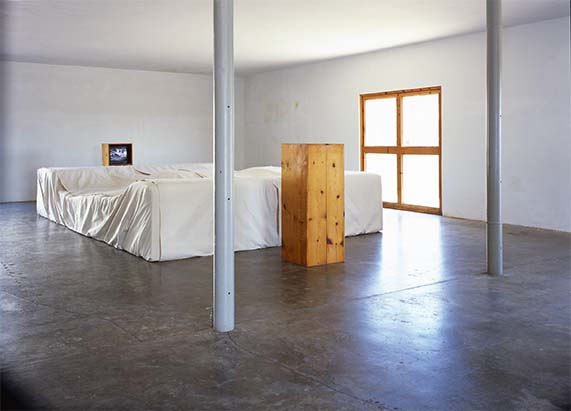American artist John Chamberlain (1927-2011) is most readily associated with those contorted, crumpled, and folded metal sculptures that were once automobiles. Their monumentality and silenced aggression can appear as eulogies to the excesses of American consumerism, as well as both the romanticism and the disaster of the highway. The work is evocative of the car accident—the wreckage by the side of the road—and suggests an accidental sculptural method, the readymade of the breakers yard. Contrary to their appearance, of course, these works are entirely intentional objects of a determined sculptural approach.
Chamberlain began a very different series of works in 1966 that provides a sculptural counterpoint to the metal ones. Using urethane foam, Chamberlain would bind with cord, slit and carve with a knife, and the resultant sculptures torque, bloom, and splay from the processes enacted upon the material. They have a playfulness and immediacy, and seem necessarily related to the human body, and somewhat sexual. The artist perhaps alluded to this latter attribute in his claim that “everybody wants one but nobody wants to buy one. I tried even to sell one to Plato’s Retreat [a swingers club in NYC]. ”1
The art market’s reticence for the foam sculptures was at least, in part, due to the perceived ephemerality of urethane foam; through exposure to light and oxygen, the works would discolor and deteriorate. Chamberlain felt that this concern was somewhat overcautious, noting that the sculptures would “probably last longer than the guys complaining about it.”2
Even though Chamberlain made at least 84 foam works during 1966-67 (and other smaller groups at various times up until 1981), the caution of the market and exhibitors rendered them nearly forgotten within Chamberlain’s oeuvre. But in 2005, Marianne Stockebrand, the then director of the Chinati Foundation in Marfa, Texas—the museum founded by artist Donald Judd to showcase his work and that of artists he admired—sought to correct this oversight with the exhibition John Chamberlain - Foam Sculptures 1966–1981 (the cover of the exhibition catalogue donned art historian Bill Jordan’s foam sculpture, Untitled, 1970, which was gifted to the Nasher in 2018). Stockebrand notes about the exhibition:
I had seen a few examples of Chamberlain’s photography when I was still living in Cologne, and I knew at that time of his foam pieces, and I knew that the Dia Foundation had a group of them. An exhibition of them seemed exactly the right thing for us to do. At Chinati, we never planned to have big temporary exhibitions. [But] Donald Judd felt that Chamberlain was not recognized to the degree he deserved, and as steward of the Judd legacy through the Chinati Foundation, I had to pursue those impulses. [With] this largely unknown group of work by Chamberlain, it was natural to be interested in the ability to focus and fully consider an overlooked body of work as a totality. When I talked to Chamberlain, he was thrilled. He didn’t get involved with the process, but he came to see the exhibition. It took quite a while, at first, to get the show together and understand where all the pieces were. We dug around and put together a nice selection of works, something like 30. I loved doing the research, and seeing the larger pieces was thrilling. At the time, almost nobody knew of them, or had seen any considerable number of them. That was a definite effect of the exhibition, to bring them to greater awareness.3
The works range in size from a few inches up to over five feet across. When diminutive, they can feel like sketches or maquettes, and when larger, the foam works also relate to another series of Chamberlain’s: the barges, or couches. These were large functional seating structures, “something terrific,” says Stockebrand. “There is a film in which you see John cutting into those big blocks of foam. He in his shorts crawling over the foam, cutting at them.”[4] This physicality of the barge's creation and their hybridity, being both functional seating and art object, extends the bodily relationship present in the smaller foam sculptures. Additionally, the sight of the barges in use— covered with a sprawl of bodies clambering and lounging—makes them appear as a precursor to relational aesthetics written through the louche social idealism of the 1960s.

John Chamberlain, Barge Marfa, 1983. Permanent collection, the Chinati Foundation, Marfa, Texas. Photography by Florian Holzherr, courtesy of the Chinati Foundation. © Artists Rights Society (ARS), New York 2021
The diversity in Chamberlain’s work—which additionally includes photography, filmmaking, and sculptures made from paper, plastics, and resin—accumulates to form a complex sum embracing formal sculptural concerns alongside the social happening, with its attendant reliance on the body. Between all this, the foam works—back from obscurity due to Chinati’s 2005 exhibition—are a connective tissue.
Gavin Morrison is an independent curator and writer. He is currently working a book concerning Donald Judd's relationship with Iceland. Morrison was previously director of Skaftfell Centre for Visual Art, Seyðisfjörður, Iceland.
1 ‘Statements on John Chamberlain’s Foam Sculptures,’ in Stockebrand, M. (ed.) John Chamberlain: The Foam Sculptures. Marfa: The Chinati Foundation, p. 182.
2 Winkelmeyer, I. ’Perfection is Good for an Instant,’ in Stockebrand, M. (ed.) John Chamberlain: The Foam Sculptures. Marfa: The Chinati Foundation, p. 25.
3 Stockebrand, M. (2021) Zoom conversation with Gavin Morrison, April.
4 Ibid.